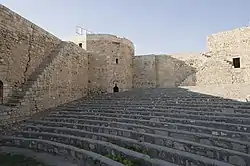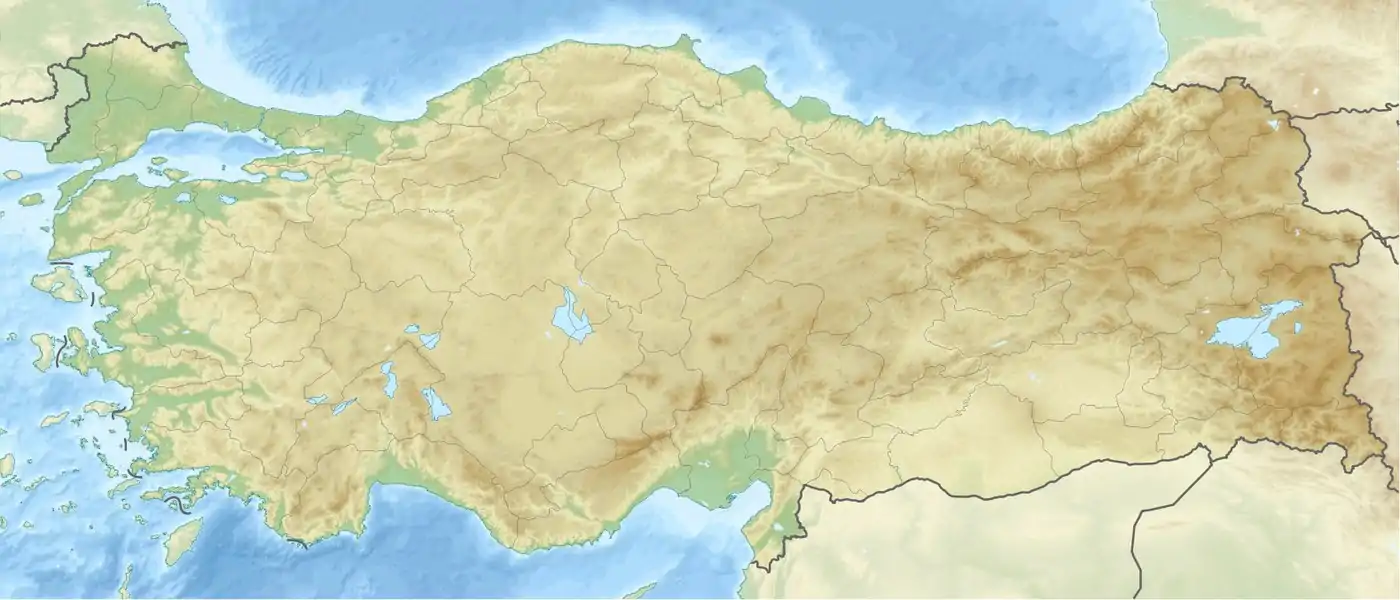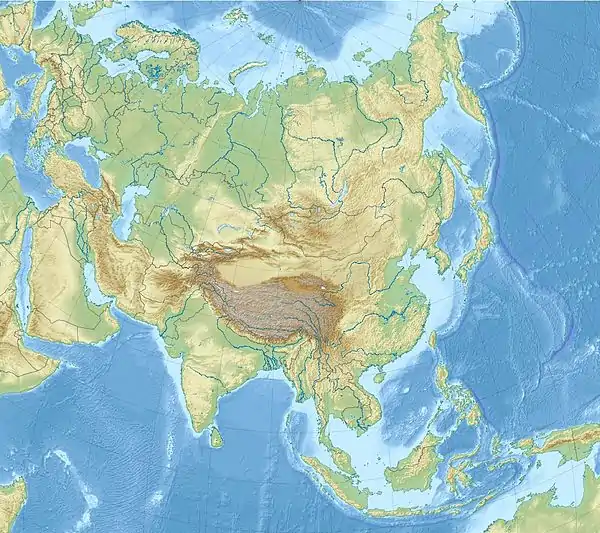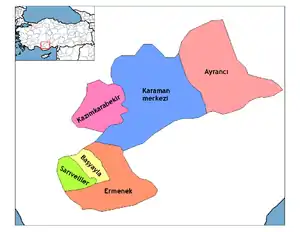Karaman
Karaman is a city in south central Turkey, located in Central Anatolia, north of the Taurus Mountains, about 100 km (62 mi) south of Konya. It is the capital district of the Karaman Province. According to 2000 census, the population of the province is 231,872 of which 132,064 live in the town of Karaman.[3][4] The district covers an area of 3,686 km2 (1,423 sq mi),[5] and the town lies at an average elevation of 1,039 m (3,409 ft). The Karaman Museum is one of the major sights.
Karaman | |
|---|---|
 Karaman fortification | |
 Karaman  Karaman  Karaman .svg.png.webp) Karaman | |
| Coordinates: 37°10′55″N 33°13′05″E | |
| Country | Turkey |
| Province | Karaman |
| Government | |
| • Mayor | Savaş Kalaycı (MHP) |
| Area | |
| • District | 3,685.73 km2 (1,423.07 sq mi) |
| Population (2012)[2] | |
| • Urban | 141,630 |
| • District | 175,397 |
| • District density | 48/km2 (120/sq mi) |
Etymology
The town owes its name to Karaman Bey who was one of the rulers of the Karamanid dynasty. The former name Laranda which in turn comes from the Luwian language Larawanda, literally "sandy, a sandy place".[6]
History
In ancient times Karaman was known as Laranda[7] (Greek: Λάρανδα). In the 6th century BC it came under Achaemenid rule until 322 BC, when it was destroyed by Perdiccas,[7] a former general of Alexander the Great, after he had defeated Ariarathes, king of Cappadocia.[8] It later became a seat of Isaurian pirates. At some point it was possessed by Antipater of Derbe.[9] It belonged to the Roman and later Byzantine Empire until it was captured by the Seljuks in the early 12th century. Karaman was occupied by Frederick Barbarossa in 1190[7] and by Armenian Kingdom of Cilicia between 1211 and 1216. In 1256, the town was taken by Karamanoğlu Mehmet Bey and was renamed Karaman in his honour. From 1275, Karaman was the capital of the Karamanid beylik.
In 1468 the Karamanids were conquered by the Ottomans and in 1483 the capital of the province was moved to Konya. Karaman has retained ruins of a Karamanid castle and some walls, two mosques and a Koran school (madrasah) from that age. An exquisite mihrab from a mosque from Karaman can now be found in the Çinili Pavilion near the Archeology Museum in Istanbul. The Karamans were Cappadocian Turkomans who fought the Ottomans on the side of the Comnenes, became Christian and migrated westwards.
There was a Roman Catholic titular see for the city.[10] The poet Yunus Emre (c. 1238–1320) resided in Karaman during his later years and is believed to lie buried beside the Yunus Emre Mosque. A small adjacent park is adorned with quotations from his verse, many of them unfortunately graffiti-splattered. In 1222, the Sufi preacher Bahaeddin Veled arrived in town with his family, and the Karamanoğlu emir built a medrese to accommodate them. Veled's son was the famous Mevlana Jelaluddin Rumi, who married his wife, Gevher Hatun, while his family was living in Karaman. It was here, too, that Rumi's mother died in 1224. She was buried, along with other family members, in the Aktekke Mosque (also known as the Mader-i Mevlana Cami), which Alaeddin Ali Bey had built to replace the original medrese in 1370.[11]
The Greek name Karamanlis as well as other surnames beginning with Karaman refer to this town. When Jefferson fought Libya's Barbary Pirates, he replaced one member of the al-Qaramanli dynasty with another as Pasha.
Notable people
- Nestor of Laranda, an epic poet, the father of the poet Peisander.[12]
- Peisander of Laranda an epic poet, the son of the poet Nestor.[12]
Gallery
 Karaman Street view
Karaman Street view Karamans Anadolu Otelcilik ve Turizm Meşlek Lisesi
Karamans Anadolu Otelcilik ve Turizm Meşlek Lisesi Karaman Yunus Emre monument
Karaman Yunus Emre monument Karaman Nefesi Sultan Medresesi monumental entrance
Karaman Nefesi Sultan Medresesi monumental entrance Karaman Medrese of Nefesi Sultan
Karaman Medrese of Nefesi Sultan Karaman Hac Beyler Mosque Entrance
Karaman Hac Beyler Mosque Entrance Karaman Haci Beyler Camisi entrance
Karaman Haci Beyler Camisi entrance Karaman Ibrahim Bey Imareti door
Karaman Ibrahim Bey Imareti door Karaman Ibrahim Bey Mosque
Karaman Ibrahim Bey Mosque Ibrahim Bey Mihrab in Çinili Köşk
Ibrahim Bey Mihrab in Çinili Köşk Karaman Castle Mosque and surroundings
Karaman Castle Mosque and surroundings Karaman Castle mosque
Karaman Castle mosque Karaman Ak Tekke interior
Karaman Ak Tekke interior Karaman Castle Exterior
Karaman Castle Exterior Karaman Castle Interior
Karaman Castle Interior Karaman Museum Can Hasan I Pottery
Karaman Museum Can Hasan I Pottery Karaman Museum Iconostasis doors
Karaman Museum Iconostasis doors Karaman Museum Kadın fez süsü
Karaman Museum Kadın fez süsü Karaman Museum Cowry shell adorned objects
Karaman Museum Cowry shell adorned objects
Climate
Karaman has a cold semi-arid climate under Köppen climate classification (BSk), with hot and dry summers and cold and snowy winters. Karaman is a very sunny city all year long.
| Climate data for Karaman (1960-2012) | |||||||||||||
|---|---|---|---|---|---|---|---|---|---|---|---|---|---|
| Month | Jan | Feb | Mar | Apr | May | Jun | Jul | Aug | Sep | Oct | Nov | Dec | Year |
| Record high °C (°F) | 21.2 (70.2) |
20.5 (68.9) |
28.7 (83.7) |
32.3 (90.1) |
34.3 (93.7) |
36.9 (98.4) |
40.4 (104.7) |
40.4 (104.7) |
36.4 (97.5) |
33.2 (91.8) |
25.7 (78.3) |
22.3 (72.1) |
40.4 (104.7) |
| Average high °C (°F) | 5.4 (41.7) |
7.0 (44.6) |
12.3 (54.1) |
18.0 (64.4) |
23.0 (73.4) |
27.7 (81.9) |
31.1 (88.0) |
31.0 (87.8) |
27.1 (80.8) |
20.8 (69.4) |
13.5 (56.3) |
7.6 (45.7) |
18.7 (65.7) |
| Daily mean °C (°F) | 0.4 (32.7) |
1.6 (34.9) |
6.0 (42.8) |
11.3 (52.3) |
16.1 (61.0) |
20.4 (68.7) |
23.5 (74.3) |
22.9 (73.2) |
18.5 (65.3) |
12.8 (55.0) |
6.7 (44.1) |
2.6 (36.7) |
11.9 (53.4) |
| Average low °C (°F) | −4.0 (24.8) |
−3.0 (26.6) |
0.2 (32.4) |
4.8 (40.6) |
8.5 (47.3) |
12.2 (54.0) |
15.0 (59.0) |
14.4 (57.9) |
10.0 (50.0) |
5.7 (42.3) |
1.0 (33.8) |
−1.7 (28.9) |
5.3 (41.5) |
| Record low °C (°F) | −25.8 (−14.4) |
−28.0 (−18.4) |
−20.2 (−4.4) |
−8.3 (17.1) |
−2.2 (28.0) |
3.4 (38.1) |
6.4 (43.5) |
5.6 (42.1) |
−1.0 (30.2) |
−5.4 (22.3) |
−21.2 (−6.2) |
−26.1 (−15.0) |
−28.0 (−18.4) |
| Average precipitation mm (inches) | 41.6 (1.64) |
35.6 (1.40) |
36.2 (1.43) |
37.1 (1.46) |
36.7 (1.44) |
21.0 (0.83) |
4.6 (0.18) |
4.2 (0.17) |
6.9 (0.27) |
27.5 (1.08) |
33.0 (1.30) |
45.5 (1.79) |
329.9 (12.99) |
| Average rainy days | 10.2 | 10.0 | 9.5 | 8.4 | 8.7 | 4.9 | 1.5 | 1.1 | 1.8 | 6.1 | 7.0 | 10.2 | 79.4 |
| Mean monthly sunshine hours | 111.6 | 126 | 201.5 | 237 | 313.1 | 363 | 403 | 378.2 | 315 | 235.6 | 168 | 108.5 | 2,960.5 |
| Source: Devlet Meteoroloji İşleri Genel Müdürlüğü | |||||||||||||
See also
References
- "Area of regions (including lakes), km²". Regional Statistics Database. Turkish Statistical Institute. 2002. Retrieved 2013-03-05.
- "Population of province/district centers and towns/villages by districts - 2012". Address Based Population Registration System (ABPRS) Database. Turkish Statistical Institute. Retrieved 2013-02-27.
- Turkish Statistical Institute. "Census 2000, Key statistics for urban areas of Turkey" (in Turkish). Archived from the original (XLS) on 2007-09-27. Retrieved 2008-03-20.
- GeoHive. "Statistical information on Turkey's administrative units". Archived from the original on 2007-10-19. Retrieved 2008-03-20.
- Statoids. "Statistical information on districts of Turkey". Retrieved 2008-04-12.
- Bilge Umar. Türkiye'deki Tarihsel Adlar. İnkılap Kitabevi, 1993. ISBN 975-10-0539-6.
- Chisholm, Hugh, ed. (1911). . Encyclopædia Britannica. 15 (11th ed.). Cambridge University Press. p. 676.
- Diodorus Siculus 18.22.1-2
- Strabo, Geography, §12.6.3
- Herbermann, Charles, ed. (1913). . Catholic Encyclopedia. New York: Robert Appleton Company.
- "Today's Zaman". Archived from the original on 2012-06-29., todayszaman.com
- Suda Encyclopedia, §nu.261
External links
| Wikimedia Commons has media related to Karaman. |
- District governor's official website, karaman.gen.tr (in Turkish)
- District municipality's official website, karaman.gen.tr (in Turkish)
- The official Facebook Page Karaman, facebook.com/KaramanHaberleri (in Turkish)
- Extensive photo site with highlights of the town, (in English)
- Extensive photo site with objects at the museum, (in English)
